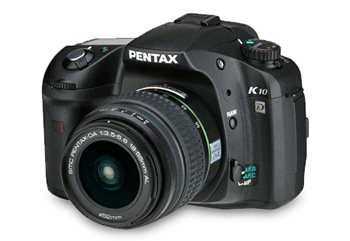
Pentax Digital SLR Cameras and Lenses
a photo.net guide by Hannah Thiem
 All Pentax digital SLR bodies are compatible with older Pentax film lenses (FA, F and A mounts) as well as newer lenses (DA and DA* mounts). The Pentax K10D is the cheapest weather-sealed digital SLR body on the market. Pentax offers a different approach to image stabilization than market leaders Canon and Nikon. The Pentax DSLR bodies electronically shake their sensors to compensate for camera shake, rather than adding image stabilization to specific lenses. The Pentax system is not as effective as in-lens image stabilization and it isn't very effective for long telephoto lenses, but it does work with all lenses, including old designs from the film years.
All Pentax digital SLR bodies are compatible with older Pentax film lenses (FA, F and A mounts) as well as newer lenses (DA and DA* mounts). The Pentax K10D is the cheapest weather-sealed digital SLR body on the market. Pentax offers a different approach to image stabilization than market leaders Canon and Nikon. The Pentax DSLR bodies electronically shake their sensors to compensate for camera shake, rather than adding image stabilization to specific lenses. The Pentax system is not as effective as in-lens image stabilization and it isn't very effective for long telephoto lenses, but it does work with all lenses, including old designs from the film years.
This article covers every current Pentax product and some good third-party components.
If you are new to photography, you might want to read "Building a Digital SLR System". The same principles can be applied to the Pentax DSLR system.
Contents
- Bodies
- Nomenclature

- Normal Lenses
- Wide-to-Telephoto Zoom Lenses
- Wide-angle Zoom Lenses
- Telephoto Zoom Lenses
- Wide-angle Prime Lenses
- Telephoto Prime Lenses
- Macro Lenses
- Flashes
- Accessories
- Starter Systems
- More
- Discontinued Pentax Cameras and Lenses
Bodies
All Pentax digital SLR bodies incorporate an APS-C sized sensor. The sensor size is 23.5x15.7mm, smaller than the standard 35mm film frame (36x24mm). The small or "crop" sensor on the Pentax DSLR bodies means that lenses don't function the way that they do on a film camera. Multiply focal lengths by 1.5x to calculate the "35mm equivalent". A 50mm lens that would be "normal" for a film camera, for example, will function as a good portrait lens on a Pentax digital body. This magnification will be welcomed by wildlife photographers and cursed by owners of high-quality high-speed wide-angle lenses (a dramatic 21mm gives a boring 31mm equivalent perspective).
- Pentax K20D, $670 (review), 14 MP, this model replaces the K10D, offers in-camera image stabilization, and extensive weather and dust seals.
- Pentax K10D, $899 (review), competes with similarly priced cameras from Canon and Nikon by offering similar 10-megapixel image quality, similar sensor cleaning, in-camera image stabilization (1 or 2 f-stops), and superior dust/weather-sealing. The K10D is also available as a kit with a low quality mid-range zoom: Pentax K10D, 18-55mm kit, $1000 (review).
- Pentax K200D, $508, released January 2008, similar to the K10D with the same 10-megapixel image quality, but with a simple design and layout for new DSLR users.
- The Pentax K100D comes in three variants, all of which have the same 6.1 megapixel sensor:
- Pentax K110D, $380
- Pentax K100D, $520, adds Shake Reduction.
- Pentax K100D Super, $800, released June 2007, adds Shake Reduction and Pentax's dust removal system.
- Pentax *istDL, 18-55mm kit, $485, released June 2005 and for some reason still available; no image stabilization and a primitive 3-point autofocus system. Pentax's lightest body.
Nomenclature
Josh Root
"DR" is the Pentax-original Dust Removal system, which helps keep the CCD surface dust-free.
"DA" refers to the series of lenses engineered exclusively for digital cameras. All DA-series lenses feature a responsive "Quick-Shift Focus System" that allows photographers to instantly switch the focus mode from auto to manual with a slight twist of the focus ring.
"DA*" refers to the series of lenses designed for exclusive use with Pentax digital SLR cameras. The DA* lenses feature tightly sealed, weather-resistant and dust-resistant construction for use in rain or dusty conditions.
"FA" specifies the autofocus lens series compatible with both film and digital SLR bodies.
"AL" stands for "aspherical lens."
"FA-J" designates a line of cheaper autofocus lenses without an aperture ring, compatible with both film and digital SLR bodies.
"A" designates a line of old manual focus lenses.
"SP" refers to a Super Protect lens coating applied on all Pentax lenses, where the surface is coated with a special fluorine compound to repel dust, water and grease, making it easy to wipe off fingerprints and cosmetics.
"ED" is "extra-low dispersion" glass, a more expensive and higher quality glass that reduces chromatic aberration, in which light of different colors takes different paths through the lens, which would result in a dot of white light being fuzzed up by the time it reaches the film or sensor.
"IF" is internal focus, meaning that the lens does not change physical length as you focus on subjects that are closer or farther away.
"SDM" is "Supersonic Drive Motor", the Pentax equivalent to Canon's in-lens ultrasonic motor. SDM makes autofocus faster and facilitates simultaneous use of manual and autofocus, which Canon calls "full-time manual focus" and what Pentax calls "quick-shift focus system".